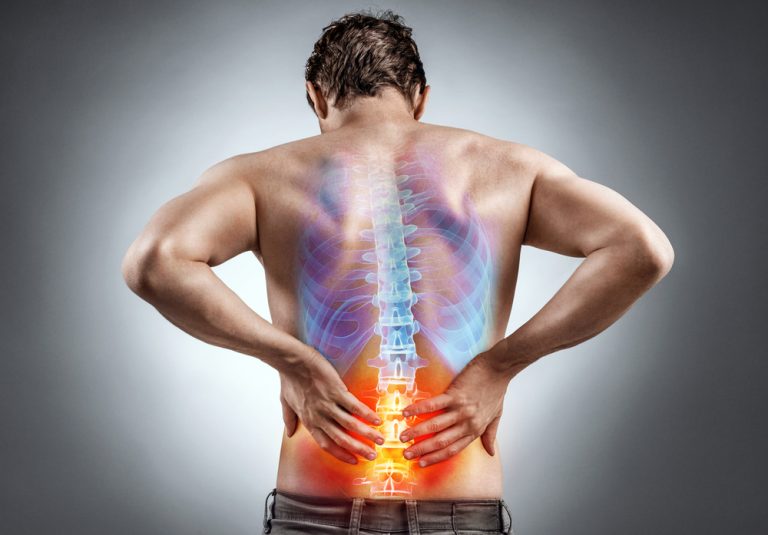Incorrect lifestyle, sitting work, small amount of movement, bad exercise technique - this usually leads to degradation and impairment of body functions. Sciatica is a condition that can happen to everyone. It appears in both physically inactive and regular training persons. What is sciatica? What are its symptoms? What exercises can be performed? Is the sciatica in the gym something special?
What is sciatica?
Sciatica, and all the symptoms associated with it, are the result of tissue compression on the large sciatic nerve. This is an important nerve because it leaves a lot of nerve branches that affect the functioning of the lower limb.
This nerve arises from a combination of several roots that come out of the spine in the lumbar region and merge into one large nerve running along the leg. The pressure on this nerve can be manifested by pain in the spine, but also in various places of the leg and numbness.
Causes of sciatica
The causes of sciatica may be several from muscle contraction to major changes in the spine or nerve.
Contoured pear-shaped muscle (pear-like muscle syndrome). Excessive tension and shortening of the small muscle running from the sacral bone to the trochanter of the larger femur will cause pressure on the sciatic nerve which may imitate the same symptoms of sciatica. The solution to this problem may be mobilization of this muscle by rolling e,g. ball, stretching exercises and strengthening of the gluteus medius muscle.

Degenerative changes in the spine.
The dislocation of the intervertebral disc (colloquially referred to as the disc). More specifically, the spinal hernia is associated with the spread of the nucleus of the crippling intervertebral disc outside the intervertebral space, which can cause nerve compression.
Swelling of the nerve root, or root inflammation.
All these causes are most often associated with an inappropriate lifestyle. Too much time spent in a sitting position, a small amount of movement, poorly fixed movement patterns - these are the ones that contribute to the development of sciatica.
Symptoms of sciatica
Sciatica manifests itself through pain of varying intensity in different places. In addition, a numbness sensation may occur. What are the most common symptoms of sciatica? That's for sure
- tingling and numbness in the lower limb, in various places;
- burning and tearing pain in the region of the loins or in various places on the leg;
- feeling of lack of muscle strength in the area of the lower limb;
In an advanced stage, you may have problems with urinating.
Sport and sciatica
What influence can sciatica have on physical activity?
Sciatica and strength training
Sciatica does not exclude participation in strength training. Before working out in the gym, it is important to consult a physician and physiotherapist. Specialists will determine exactly what kind of activity and what exercises at the gym can and should be done.
Sciatica and running
Just like the case of strength training, consultation with specialists is important. Running with a sciatica is possible, but requires great attention and focus. It is best to run correctly technically on a soft ground so as not to overload your spine.
Exercises at the gym during sciatica
During sciatica (not including the excessive tension of the pear-shaped muscle) care should be taken to relieve the spine and strengthen all the muscles that are responsible for its stability, among others stomach and buttocks. Strength exercises should be performed primarily in lying on the back, abdomen and side. These positions least burden the spine.
Which exercises are relatively safe for those suffering from sciatica?
- Pull-ups
- pressing the bar when lying on a horizontal bench, without excessive bridging
- lifting dumbbell side to side sitting on the bench
- lifting the dumbbell sideways while lying
- exercises for core muscles, e.g. a plank with front or side
- triceps exercises
- biceps exercises lying in front of a bench or sitting on a bench with a positive slant
Which exercises should be avoided during sciatica or exercise with extreme caution?
- deadlift
- squats with barbell, above all, refers to the squats with the barbell on the back where the load on the spine is greater than in the case of the barbell held in front or the weight in the hands
- bench press while standing
- press while sitting
- pressing the barbell or dumbbells on the slant
- all kinds of crunches and lifting legs to the cage in the overhang and lying down
Sciatica at the gym
Sciatica is one of many diseases that are associated with the sensation of bothersome pain. The causes of sciatica can be both trivial and very serious. Taking any activity should be consulted with a physician and physiotherapist, but performing the appropriate exercises is crucial in the rehabilitation of this disease. Sciatica in the gym is also quite a popular disease, so everyone should know what it is and how to deal with it.






